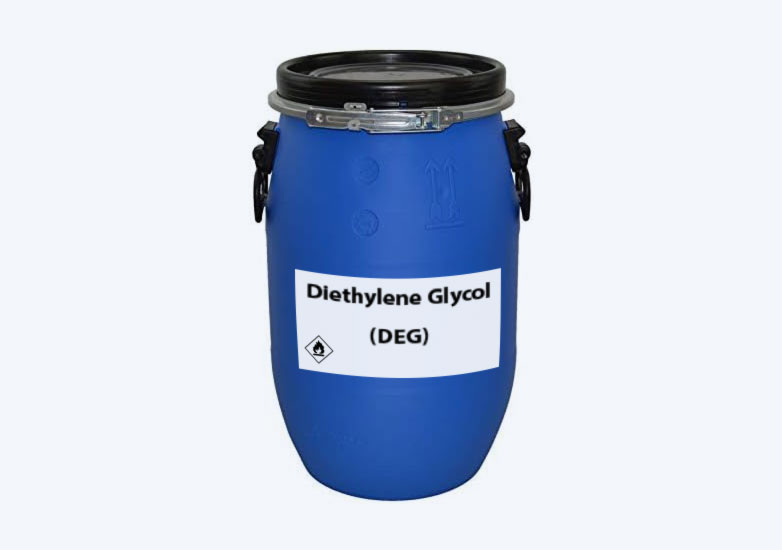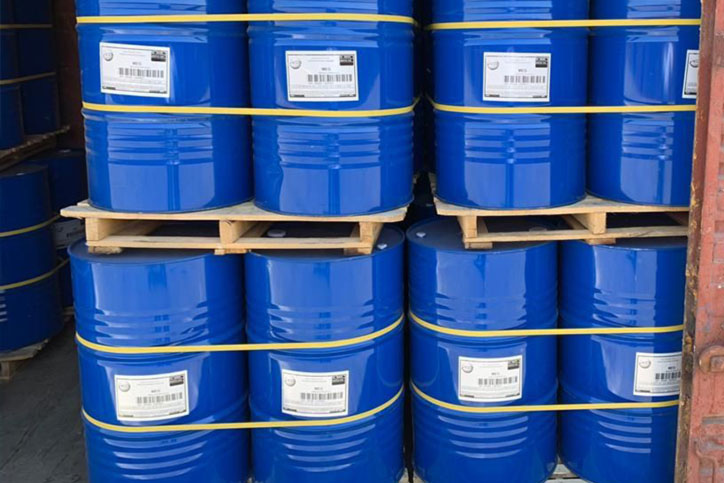Diethylene Glycol – CAS#: 111-46-6
Bulk Order
Diethylene glycol serves a variety of purposes in different industries. It is utilized in the production of unsaturated polyester resins, plasticizers, and polyurethanes. It also acts as a solvent for organic compounds such as nitrocellulose, oils, resins, and dyes. In addition, it is a key component in brake fluid, lubricants, and heating/cooking fuel. Furthermore, it can be found in personal care products such as skin creams, lotions, and deodorants.
Diethylene glycol (DEG) is an organic compound with the formula (HOCH2CH2)2O. It is a colorless, practically odorless, poisonous, and hygroscopic liquid with a sweetish taste. It is miscible in water, alcohol, ether, acetone, and ethylene glycol. DEG is a widely used solvent.
ISO 9001, ISO 14001, ISO 13485, and ISO 45001
| Market: | Reagents |
|---|---|
| Class | Glycols |
| MOLECULAR WEIGHT | 106.12 |
| APPEARANCE | Colorless viscous liquid |
| DENSITY | 1.118 g/cm3 |
| REFRACTIVE INDEX | 1.447 |
| ASSAY | ≥99.0 % |
| BOILING POINT | 245 °C |
| MELTING POINT | −10 °C |
- ISO Containers
- Drums
- Intermediate Bulk Containers (IBCs)
What is the Diethylene Glycol?
Diethylene glycol (DEG) is a colorless, odorless, and hygroscopic (water-absorbing) liquid with a sweet taste. It is an organic compound that belongs to the family of glycols, which are compounds that contain two hydroxyl (-OH) groups attached to adjacent carbon atoms. DEG is a versatile chemical that is used in various industrial applications, including the production of resins, plastics, and textiles. It is also used as a solvent for a variety of organic compounds, such as oils, dyes, and resins. Additionally, DEG can be found in consumer products such as personal care items, pharmaceuticals, and antifreeze.
Synonyms 1,5-Dihydroxy-3-oxapentane I 2,2′-dihydroxydiethyl ether I 2,2′-Oxydiethanol
What is Diethylene Glycol Used For?
Diethylene glycol (DEG) is a versatile chemical with a wide range of industrial and consumer applications. Here are some of the most common uses of DEG:
DEG is used in the production of a variety of products, including polyester resins, polyurethanes, and plasticizers.
DEG is an effective solvent for a variety of organic compounds, such as oils, dyes, and resins.
It’s used as a component in antifreeze, which is added to automotive and industrial cooling systems to prevent freezing and corrosion.
Used in the production of personal care products, such as skin creams, lotions, and deodorants.
Used as a solvent and a stabilizer in the production of pharmaceuticals.
Diethylene Glycol is used in the production of textile fibers, such as polyester and nylon.
It’s used as a solvent in the production of adhesives, such as those used in the construction industry.
Diethylene Glycol Industry Used
This substance is used in the production of the following materials:
- Chemical manufacturing
- Solvent
- Antifreeze
- Personal care products
- Pharmaceuticals
- Textile industry
- Adhesives
Diethylene Glycol Safety Procedures
Diethylene glycol (DEG) can be hazardous if it is not handled or used properly. Here are some safety procedures to follow when working with DEG:
- Wear personal protective equipment (PPE): When working with DEG, it is important to wear appropriate PPE, such as chemical-resistant gloves, safety glasses, and a lab coat or protective clothing.
- Handle with care: DEG should be handled with care to avoid spills or splashes. Always use proper lifting techniques and avoid dropping or jostling containers of DEG.
- Store properly: DEG should be stored in a secure, designated area away from other chemicals or materials that could react with it. It should be stored in a cool, dry, well-ventilated area and kept away from sources of heat or ignition.
- Use only in well-ventilated areas: DEG should only be used in areas with adequate ventilation to prevent the buildup of toxic fumes or vapors.
- Use appropriate handling equipment: When transferring or dispensing DEG, use appropriate handling equipment such as pumps or funnels to avoid spills or splashes.
- Know how to neutralize spills: In the event of a spill, it is important to know how to properly neutralize and clean up the DEG. This may involve using a neutralizing agent or contacting emergency services for assistance.
- Train employees: All employees who work with or around DEG should receive thorough training on proper handling and safety procedures. This should include information on the hazards of the chemical, proper PPE, and emergency response procedures.


